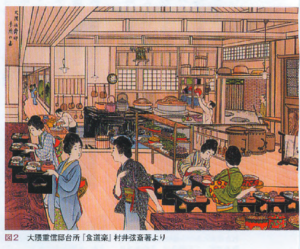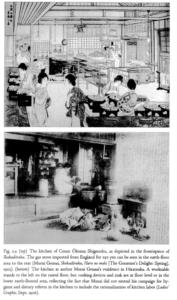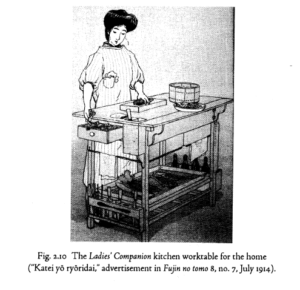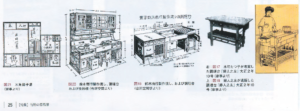Just as I cook rice in a rice cooker, some choose to use a pot over a gas stove. Japan is one such country that has transitioned from traditional wood fires, to gas, and finally electric rice cookers in the short span of two centuries. Although the rice cooker is now a quintessential item in many parts of East Asia, its history is often quite obscure and difficult to trace. Historical scholarship on the rice cooker, especially in English, appears to be quite sparse, save for Jordan Sand’s impressive account of Japanese kitchens in the Meiji Era.
A researcher on the topic would be hard pressed to turn to Japanese language sources, and rightly so. The famous insularity of Japanese research, and indeed Japanese publications as a whole means that much of the Japanese research done on the evolution of their kitchen culture is locked behind a language barrier. The result of this research existing in different realms to that of the rest of the world has produced some interesting results. Both Jordan Sand and the author of a short Japanese article in Jūtaku Kenchiku, The Housing Journal for Builders and Designers, written by Keisuke Sato (佐藤敬介) draw on similar sources to give the reader a snapshot of the kinds of technology available in kitchens during the Meiji and Taisho eras, alongside the technological innovations that changed the Japanese kitchen during this period. [1] At some points of the cross analysis of these two sources, I had to stop and question whether these were the same authors with different names, or even the possibility that Sato (due to his article being written in 2012 as opposed to Sand in 2005), had either read Sand’s work and taken inspiration or just plain plagiarised it. It only after taking a closer look at the latter parts of Sato’s article that made it apparent that both authors had chanced upon the same sources and used them in each of their respective works. Even so, it was quite startling that the narrative trajectories that each author took were so similar. From references to similar articles, to discussions of gas technology in the kitchen, and even the changing spatial nature of the “sitting to standing” role of the cook in the kitchen. It was completely flabbergasting to see almost the same topics being discussed, just in slightly different ways.
Analyzing a 2012 Japanese publication of Jūtaku Kenchiku, provided interesting insight into how kitchen technologies as a whole shifted significantly during different periods of Japan’s modernization. Sato does some excellent primary source research based on first-hand accounts of interviews and images taken from magazines throughout the Meiji and Taisho Era. Curiously, both Sato and Sand cite “Shokudōdraku” and use the exact same image from the kitchen of a certain Count Ōkuma Shigenobu. Funnily enough, the only difference in the image is that the 2012 Japanese rendering has colour, whereas Sand’s does not. Both took note that there was a large UK imported gas cooker and the implications that had on the function of this kitchen and of the shifting spatial forms in the Japanese kitchen in this era. [2] It is likely that the reason why both authors chose the image was because it was the best representation of the inner workings of a Meiji Era kitchen in an aristocratic household and provided insight into the types of appliances that were used. Perhaps it was just sheer chance that they came upon the exact same source and image, or perhaps this particular subfield of the spatial history of kitchens in Japan is so sparse that they there are few good examples to choose from. Whichever it is, it is most curious that both secondary sources converge at this specific image.

Sato’s use of ōkuma’s kitchen

Sand’s use of ōkuma’s kitchen
Whereas Sand comments on the bourgeoise nature of consumption. Sato appears to take a much more empirical and indeed personal approach to these representations in the kitchen, instead commenting on how specific appliances seem to have made the lives on housewives easier, alongside specific measurements in the form of Tsubo (the size of about 2 tatami mats) for the kitchen. [3] The easiest way to explain the differences in explanation for the exact same source would simply be the audience each author was writing for. Sand would be more interested in creating an account that was more consistent with academic forms of research that required theoretical analysis, whereas Sato was more interested in creating a practical account for those that wanted to draw inspiration from historical forms of the kitchen. You can see the split between the historical analysis and the contemporary comments on how to structure your kitchen based on change in content about halfway through Sato’s article.
Curiously, Sato appears to delve more into the quotidian aspects of kitchen life in his accounts. He took his research a step further by introducing accounts of a certain 工學博士清水家 (The House of Shimizu, Doctor of Engineering) during the Taisho era. Commenting on specific developments in gas technology that allowed “meals to be put in front of 17 people within the span of 30 minutes”. [4] These kinds of empirical accounts seemed to be of less interest to Sand as they didn’t serve to support the overarching narrative of the transformation of the Japanese woman in the kitchen. Sand’s concerns regarding the “laboratisation” of the kitchen was something that wasn’t quite discussed as much in Sato’s account, as well as accounts by other articles on kitchens that were present in an earlier 1981 article published in Jūtaku Kenchiku.
While both took different approaches to spatial practices in the kitchen and the various forms this took, there was a marked interest in gas as an innovation in kitchen technology and the transition from “sitting to standing” in the kitchen. Sato’s introduction of gas focused more on the gradual integration in Japanese society, from street-lamps in Ginza, to the advent of the gas water heater in the 35th year of Meiji. [5] Once again, similar references to gas appliance manuals and the ability of gas technology being “lit by a single match” appears. This section of Sato’s article is the only part that vaguely comments on the cleanliness of gas as an energy and cooking source, citing the lack of soot and dirt being healthier to the organs and eyes. Sand on the other hand, focuses on how gas appliances could replace the “unhygienic maid” in the search for modernity. [6] The transformation of the kitchen from a sitting to standing space was something that both authors paid very close attention towards. Sand discussed differences in the Kantō and Kansai kitchens and how the two stepped kitchens of many older models and rural environments. [7] The way that he comments on the “streamlining” of the kitchen from many individuals (such as maids and other helpers) to the single housewife was somewhat echoed by Sato, in much less specific forms. Specific references to “Taylorism” were even made by both authors as justifications for making the kitchen a space that was more “laboratory like” (to borrow Sand’s term).


The point at which the two authors begin to diverge is in discussions of the applications of these innovations to the modern kitchen. Sato draws on his own experiences in modelling kitchens from the late 1970s to the modern day and makes certain references to an ideal “kitchen triangle” between the stove, sink and fridge in the modern home. [7] Sand ends his chapter with the main narrative point of the transformation of the kitchen as a space in Meiji Japan being a reflection of the bourgeoisie, hygiene and educational norms that were beginning to pervade throughout Japanese society. [8] The comparisons of these two pieces of research has aroused a certain sense of uncanniness that is sure to be of interest to any historian. The kinder hypothesis would be that both authors chanced upon the same primary sources and analysed them in different ways. This is possible as Sato intersperses primary source research from other accounts throughout his article. The much harsher criticism would be that Sand’s original analysis was used and repackaged for a domestic journal on kitchen design by Sato.
[1] Keisuke Sato, Daitokoro no Rekishi, Jūtaku Kenchiku, 432: 4 (April 2012) pp. 23-27.
[2] Jordan Sand, House and Home in Modern Japan: Architecture, Domestic Space and Bourgeois Culture, 1880-1930. (Massachusetts, 2004.)
[3] Keisuke Sato, ‘Daitokoro no Rekishi’, p. 23.
[4] Ibid, p. 23.
[5] Ibid, p. 25.
[6] Sand, House and Home, p. 78
[7] Keisuke Sato, ‘Daitokoro no Rekishi’, p. 25
[8] Sand, House and Home, p. 79